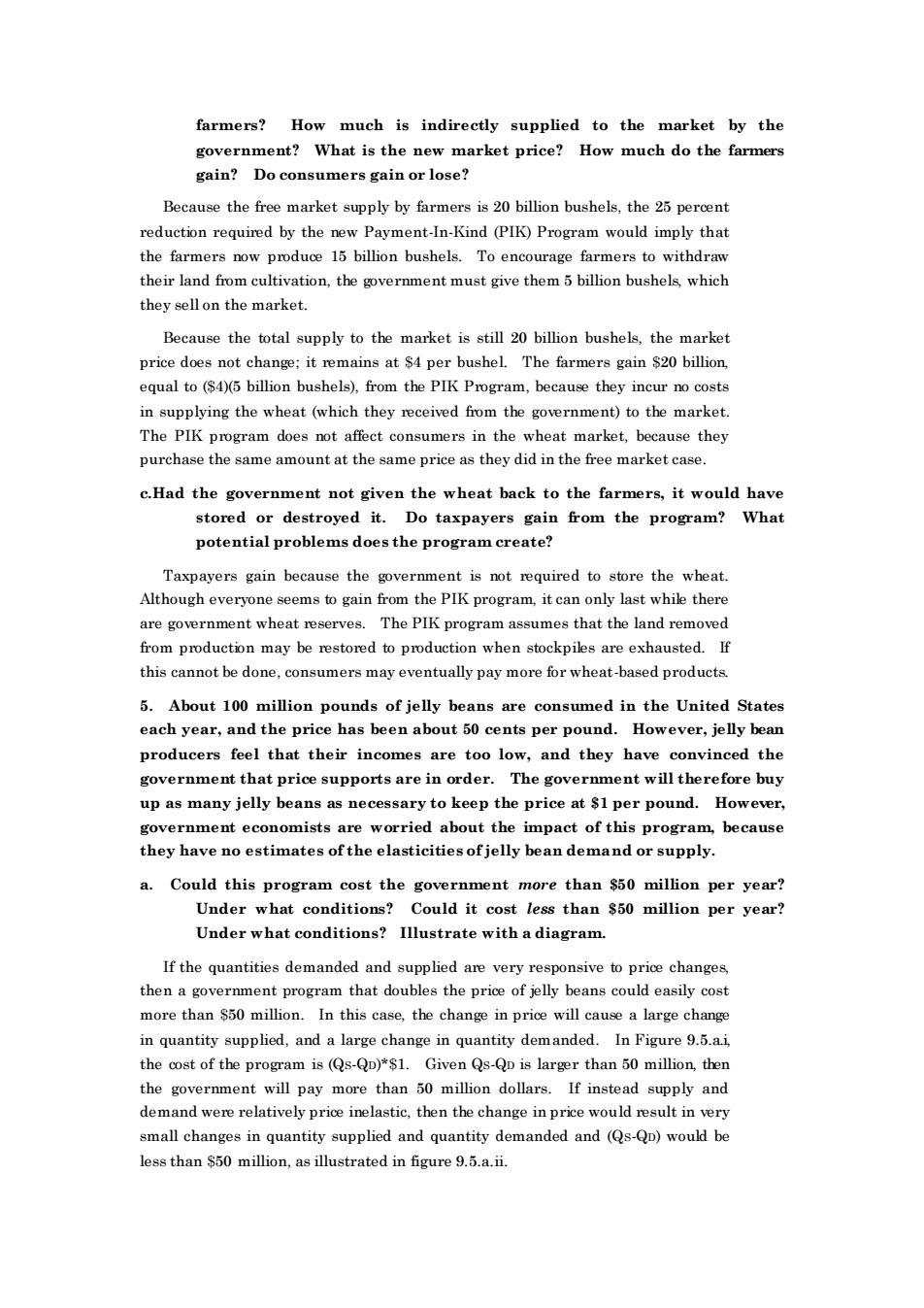正在加载图片...

farmers?How much is indirectly supplied to the market by the government?What is the new market price?How much do the farmers gain?Do consumers gain or lose? Because the free market supply by farmers is 20 billion bushels.the 25 percent reduction required by the new Payment-In-Kind(PIK)Program would imply that the farmers now produce 15 billion bushels.To encourage farmers to withdraw their land from cultivation.the overnment must give them5billion bushels which they sell on the market Because the total supply to the market is still 20 billion bushels,the market price does not ch ange;it remains at $4 per bushel.The farmers gain $20 billion, equal to ($4)(5 billion bushels).from the PIK Program,because they incur no costs in supplying the wheat (which they received from the government)to the market. The PIK program does not affect consumers in the wheat market,because they purchase the same amount at the same price as they did in the free market case c.Had the goverament not given the wheat back to would have stored or destroyed it.Do taxpayers gain from the program? Wha potential problems does the program create? Taxpayers gain because the government is not required to store the wheat. Although everyone seems to gain from the PIK program,it can only last while there are government wheat reserves.The PIK program assumes that the land removed Po业nmtd pmdiction when如arehouted cannot be done,consumers may eventually pay morefor wheat-based product 5.About 100 million Year.and tho pounds of jeny bn ae consum in the United State e has been about 50 cents per pound. However,jelly bear producers feel that their incomes are too low,and they have convinced the government that price supports are in order.The government will therefore buy up as many jelly beans as necessary to keep the price at $1per pound.However government ec 101 ists a worried about impaet of th s program,because they have no estimates ofthe elasticities ofjelly bean demand or supply. a.Could this program cost the government more than $50 million per year? Under what conditions?Could it cost less than $50 million per year? Under what conditions?Illustrate with a diagram. If the quantities demanded and supplied are very responsive to price changes then a government program that doubles the price of ielly beans could easily cost more than $50 million this case,the change in pri will au a large chango in quantity supplied,and a large change in quantity demanded.In Figure 9.5.ai the cost of the program is (Qs-QD)$1.Given Qs-QD is larger than 50 million,then the government will pay more than 50 million dollars.If instead supply and demand were relatively price inelastic.then the change in price would result in ery small changes in quantity supplied and quantity demanded and (Qs-Qo)woul be less than50 million,as illustrated in figure9.5.a.ifarmers? How much is indirectly supplied to the market by the government? What is the new market price? How much do the farmers gain? Do consumers gain or lose? Because the free market supply by farmers is 20 billion bushels, the 25 percent reduction required by the new Payment-In-Kind (PIK) Program would imply that the farmers now produce 15 billion bushels. To encourage farmers to withdraw their land from cultivation, the government must give them 5 billion bushels, which they sell on the market. Because the total supply to the market is still 20 billion bushels, the market price does not change; it remains at $4 per bushel. The farmers gain $20 billion, equal to ($4)(5 billion bushels), from the PIK Program, because they incur no costs in supplying the wheat (which they received from the government) to the market. The PIK program does not affect consumers in the wheat market, because they purchase the same amount at the same price as they did in the free market case. c.Had the government not given the wheat back to the farmers, it would have stored or destroyed it. Do taxpayers gain from the program? What potential problems does the program create? Taxpayers gain because the government is not required to store the wheat. Although everyone seems to gain from the PIK program, it can only last while there are government wheat reserves. The PIK program assumes that the land removed from production may be restored to production when stockpiles are exhausted. If this cannot be done, consumers may eventually pay more for wheat-based products. 5. About 100 million pounds of jelly beans are consumed in the United States each year, and the price has been about 50 cents per pound. However, jelly bean producers feel that their incomes are too low, and they have convinced the government that price supports are in order. The government will therefore buy up as many jelly beans as necessary to keep the price at $1 per pound. However, government economists are worried about the impact of this program, because they have no estimates of the elasticities of jelly bean demand or supply. a. Could this program cost the government more than $50 million per year? Under what conditions? Could it cost less than $50 million per year? Under what conditions? Illustrate with a diagram. If the quantities demanded and supplied are very responsive to price changes, then a government program that doubles the price of jelly beans could easily cost more than $50 million. In this case, the change in price will cause a large change in quantity supplied, and a large change in quantity demanded. In Figure 9.5.a.i, the cost of the program is (QS-QD)*$1. Given QS-QD is larger than 50 million, then the government will pay more than 50 million dollars. If instead supply and demand were relatively price inelastic, then the change in price would result in very small changes in quantity supplied and quantity demanded and (QS-QD) would be less than $50 million, as illustrated in figure 9.5.a.ii